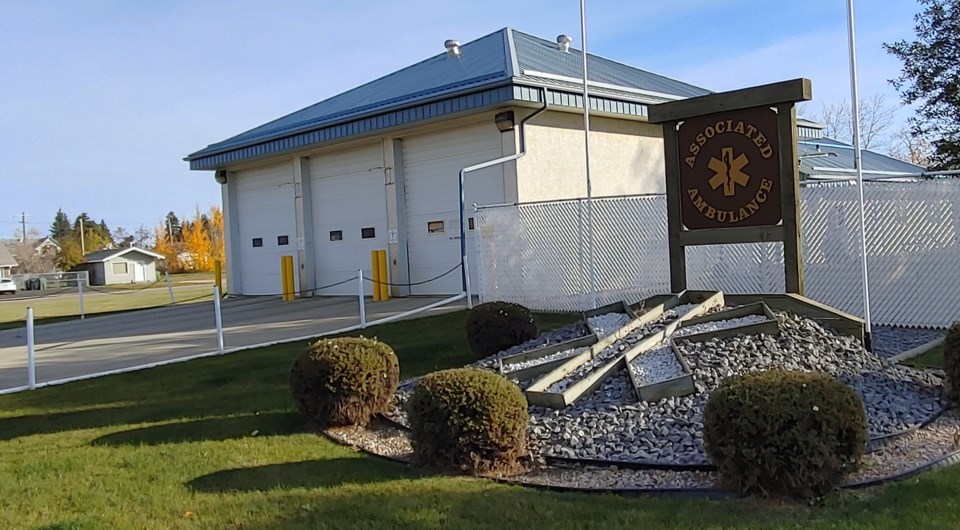WESTLOCK – The EMS staffing shortage, while alarming, is not new according to Health Sciences Association of Alberta (HSAA), a union representing over 27,000 health professionals and Associated Ambulance, who are contracted to provide ambulance service across rural Alberta.
The situation was highlighted on Oct. 5 when HSAA issued a red alert for Barrhead and Westlock, meaning no ambulances were available for a short period of time.
“They can last a few seconds to hours, depending on when they are happening,” said Mike Parker, president of HSAA. “In rural areas red alerts can last hours because the ambulance crews have been sent to emergency calls in the city or another area of the province.”
Parker says that travel times to and from calls in rural areas account for a majority of the time spent in red alert status, noting that some crews are dispatched to calls more than 100 kilometres away with response times of over an hour.
“Think about the impact that has on the sick or injured person that is needing care. That has a very real impact on the loved ones caring for the person until paramedics get there.”
But it’s not always ambulances being called away that is the cause of red alerts. Sometimes red alerts are issued due to staffing. Parker says that over the past decade staffing has gotten continually worse, which means that even if an area has more than one ambulance, only a limited number can be manned at any given time due to a lack of manpower.
“It just keeps getting worse. There has been no significant increase in the number of paramedics in Alberta,” Parker explained. “To put it in simple to understand terms for government – supply is not keeping pace with demand.”
While the COVID-19 pandemic and ongoing opioid crisis play a factor in forces being spread thin, Parker says the situation was bad “before either of those became a factor” and “they are bringing a sharp focus to the magnitude of the problem.”
Seeing consistent issues with staffing, he hopes that the situation is addressed in a proper manner and funding is allocated to hire more paramedics.
"It is devastating to the well-being of paramedics. Imagine dedicating your life to helping others and being trained to do exactly that – and then sitting in an ambulance for more than an hour trying to get to a patient. It takes a huge toll on everyone involved,” said Parker.
Meanwhile Associated Ambulance’s executive director of operations Paul Kennedy says the issue of staffing has only grown worse with the fourth wave of the COVID-19 pandemic.
“Over the past three to four months, there’s been issues with staffing because of people being off for various reasons. Sickness, mental health, COVID-19, workers comp injuries,” said Kennedy.
Contracted by Alberta Health Services (AHS), Associated Ambulance provides service to rural Alberta. And providing that service has been an issue for the past decade with a clear lack of licenced paramedics and EMS workers.
“There’s been a shortage in this province for 10 years. I hire every month but there’s been a shortage of licenced practitioners in the province. It’s a shortage because of the compounding problem of people being off.”
Kennedy says EMS can be spread thin, causing red alerts when ambulances are called to service areas where they are the nearest resource.
“They’ll do a call in the city if one comes. Then if they’re driving back to Westlock and there’s a call in Morinville, they’ll go there. If they’re the closest resource they’ll be sent anywhere in the province.”
In a statement released to The Westlock News via e-mail on Oct. 7, AHS acknowledged that there “may have been very short periods of time when the EMS ambulances stationed in either Westlock or Barrhead were tending to patients on Oct. 5.”
Though this meant there were none available in the community, AHS explained that EMS ambulances from neighbouring communities were available to provide temporary coverage for Barrhead and Westlock, saying it is “inaccurate to take a snapshot of one moment in time and use it to assess an entire hour or full day.”
AHS says they are receiving an unprecedented increase in emergency calls due to the COVID-19 pandemic and opioid concerns in addition to regular calls, which is putting strain on the system.
“We are ensuring that the most critical patients are prioritized for receiving immediate care,” AHS said in the release. “Ambulances are a provincial resource, and while they may be based in one location this does not mean they serve only that location.”
AHS added that they have brought on additional staff to help support the increase in calls, filling 100 paramedic positions across the province as well as offering overtime to willing staff.
“EMS staff are working extremely hard to provide timely care to Alberta patients and we thank them for their tireless service,” AHS concluded.



